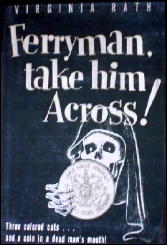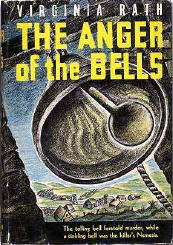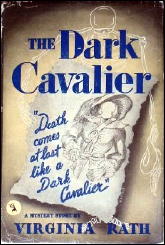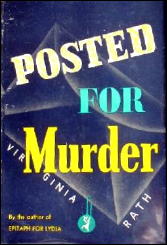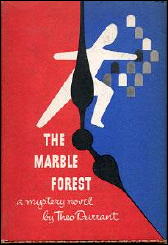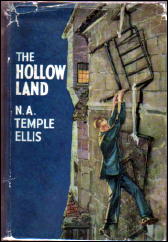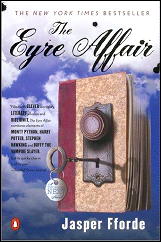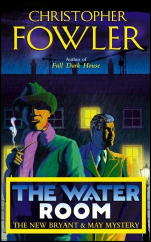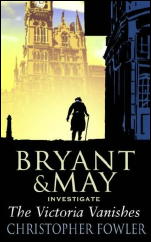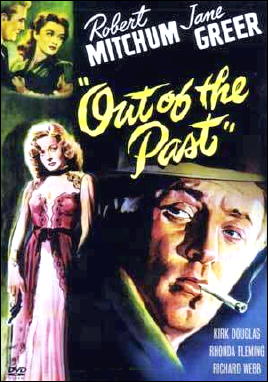May 2011
Monthly Archive
Thu 12 May 2011
VIRGINIA RATH – An Excellent Night for a Murder. Doubleday, Doran & Co. / Crime Club, hardcover, 1937.
All things being equal, I’m willing to bet that if I weren’t here to tell you otherwise, you’d have identified Rocky Allan as one of those rough-and-tumble cowboy stars who starred in a long list of those well-remembered B-western moving pictures of a generation or so back.
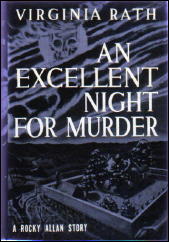
And while he’s actually the detective hero in a series of mystery novels written by author Virginia Rath, to tell the truth, you’d still not be so very far from being wrong.
In this book he’s the sheriff of a small country town called Brookdale, which I gather is somewhere in California. Even though this is his fifth recorded adventure, I seem also to have gotten the impression that he’s not been the sheriff there for very long. I don’t know why I’m not sure of these things, but it’s obvious that some research into his earlier cases seems warranted. I’ll have to report in with more information on this later.
As the story opens, a stranger to Brookdale is taken in by the Graydons, the biggest name in that part of the country, but he’s quickly thrown out, and on one of the rainiest nights of the year. He makes his way into town on foot, and he wakes up dead the next morning in his hotel bedroom. He was a blackmailer, as you might have guessed by now, and a very cooperative one at that, leaving so many victims behind like this to serve as murder suspects.
The murder investigation is a fairly predictable one, but Rath does a surprisingly fine job in utilizing the folksy, small-town way of living both as background and as a general atmosphere. Surprisingly, for when was the last time you heard the name Virginia Rath mentioned in conversation, even with a fellow aficionado?
Facts are realistically uncovered in haphazard fashion, too often in the wrong order, and there’s a good twist or two hidden in the end, somewhere midst the clutter caused by having a few too many characters on hand.
Don’t get the idea that Rath writes only of a hick sheriff in a one-horse town, however. Rocky Allan is still a young guy, and he’s sharper than that. And while his meeting with Pearl in a San Francisco hotel room is downplayed, it’s quite definitely a highlight of the book.
— Reprinted from The MYSTERY FANcier, Vol. 3, No. 6, Nov/Dec 1979 (slightly revised).
Bio-Bibliographic Data:
A biographic profile of Virgina Rath can be found on the Ziff-Davis “Fingerprint Mystery” page of the primary Mystery*File website (follow the link and scroll down).
From the Revised Crime Fiction IV, by Allen J. Hubin:
RATH, VIRGINIA (Anne McVay), 1905-1950. Pseudonym: Theo Durrant.
* Death at Dayton’s Folly (n.) Doubleday 1935 [Sheriff Rocky Allan; California]
* Ferryman, Carry Him Across! (n.) Doubleday 1936 [Sheriff Rocky Allan; California; Academia]
* Murder on the Day of Judgment (n.) Doubleday 1936 [Sheriff Rocky Allan; California]
* The Anger of the Bells (n.) Doubleday 1937 [Sheriff Rocky Allan; California]
* An Excellent Night for Murder (n.) Doubleday 1937 [Sheriff Rocky Allan; California]
* The Dark Cavalier (n.) Doubleday 1938 [Michael Dundas; San Francisco, CA]
* Murder with a Theme Song (n.) Doubleday 1939 [Sheriff Rocky Allan; Michael Dundas; California]
* Death of a Lucky Lady (n.) Doubleday 1940 [Michael Dundas; San Francisco, CA]
* Death Breaks the Ring (n.) Doubleday 1941 [Michael Dundas; California]
* Epitaph for Lydia (n.) Doubleday 1942 [Michael Dundas; San Francisco, CA]
* Posted for Murder (n.) Doubleday 1942 [Michael Dundas; San Francisco, CA]
* A Dirge for Her (n.) Ziff-Davis 1947 [Michael Dundas; San Francisco, CA]
* A Shroud for Rowena (n.) Ziff-Davis 1947 [Michael Dundas; San Francisco, CA]
DURRANT, THEO. Pseudonym of William A. P. White, Terry Adler, Eunice Mays Boyd, Florence Ostern Faulkner, Allen Hymson, Cary Lucas, Dana Lyon, Lenore Glen Offord, Virginia Rath, Richard Shattuck, Darwin L. Teilhet & William Worley.
* The Marble Forest (n.) Knopf 1951 [California]
* The Big Fear (n.) Popular Library 1953. See: The Marble Forest (Knopf 1951)
Wed 11 May 2011
THE SERIES CHARACTERS FROM
DETECTIVE FICTION WEEKLY
by MONTE HERRIDGE
#3. ARTY BEELE, by Ruth & Alexander Wilson.
The Arty Beele stories by Ruth and Alexander Wilson were a short series of at least sixteen stories (some short stories and some novelette length) published in Detective Fiction Weekly from 1928 to 1932. There could be more.
The character’s full name is Arthur Welliver Beele. The series involves the exploits of a hardboiled newspaper crime reporter in the Prohibition era. The stories are a bit hardboiled, too; an early example of this type of story.
Beele is not afraid of gangsters and racketeers; he associated with them considerably and they gave him good stories. This doesn’t mean that all criminals liked him. Beele would without any compunction insult a known criminal and act unafraid of the consequences.
Beele could often acquire information about goings on with the police and underworld. On one occasion “It had come to Arty Beele’s attention, by one of those devious routes that were at once the despair and the astonishment of his city editor…†(The Fragrant Alibi)
In a number of the stories, John Ryan, captain of the homicide squad, leads the investigations and somewhat disapproves of Beele, but lets him ask many questions. Harrington, the Telegraph newspaper’s city editor, is a friend of his.
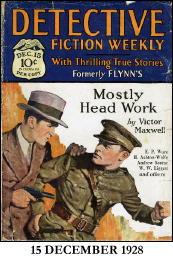
The descriptions given of Beele are sketchy, but one statement about Beele is “a tall, untidy figure crowned with a disreputable Stetson…†(A Pain in the Neck) He also has a beaky, hawk nose. Beele does not let himself get involved with women, “he distrusted and detested women.†(Strike Three!)
In the first story in the series, “Killers Have Blue Eyes†(December 15, 1928) Beele tells Hymie Jacobs, a known gunman, that he is yellow. He also notes that killers always have blue eyes, and Jacobs doesn’t. The story is a simple one where Jacobs’ enemy, another gunman, is killed. Beele knows that Jacobs didn’t kill him, and suspects who did. But Beele convinces Jacobs to confess to the killing.
“The Silent Witness†details the aftermath of a killing of Brady, a gangland leader, supposedly by his girl friend Floss Jordan. But Arty Beele sees something that others don’t see, and believes she is innocent. He plays this up in his newspaper writings, and gets a lawyer friend of his to represent the accused woman. Part of the story is a relation of the court trial, and its results.
“A Ride in the Park†does not involve a mystery, but does involve a murder. When gangster Tony Costello arrives back in town, Arty Beele expects that he will be killed by enemies. When a killing does take place at the train station, Beele jumps to the conclusion it was Costello and writes up an article about it.
The piece was not complimentary to Costello, and he it turns out was not killed. Costello waylays Beele and takes him for a ride, intending to kill him. Beele manages to wreck to the car and kill Costello. A very close call for Arty Beele.
“Death in the Dark†is a longer story than many others in the series, being of novelette length. It is a better story, as it enables the author to spend more time on details and the characters. Beele is sent by Harrington, his editor, to the house of a rich man who has been mysteriously shot while a police patrolman was not too far away.
The only witness is too drunk to tell anyone anything, and there seems to be no place that the murderer could have gone after the crime. The crime was a complicated scheme to provide an alibi for the murderer, and it takes Arty Beele to see through it. He had the cooperation of Captain Ryan here.
“This Way Out†doesn’t involve a mystery, although someone is murdered in it. One of Arty Beele’s gangster friends named Al Donner is in trouble with the law for a murder. Beele doesn’t believe he did it, although he knows that Donner did murder someone else a short time before. So Beele gets Donner a lawyer to defend him in court, and backs up Donner. Beele feels an obligation to Donner because Donner saved his life once. This is another novelette length story.
“A Pain in the Neck†is a murder mystery where Arty Beele is involved with the police in solving the case of a fight manager who has been strangled. The obvious suspect is the manager’s boxer, but Beele sees clues the others have missed and points out the correct killer.
“A Swell Funeral†involves the murder of a racketeer leader at his recently opened nightclub, the Club Seville. Arty Beele is a friend of the racketeer, Dan O’Malley, and happens to be in the club at the time that he was killed. Strangely, no one saw the shooting at the front door where O’Malley fell dead.
Captain Ryan is soon on the scene, and Beele insists on being a part of the investigation. Various other men, some of them racketeers also, come under suspicion. As usual, Beele comes up with the solution, with the cooperation of the police.
“Special Delivery†is of novelette length, and is a story of gangsters and the newspaper. Scarron, the local liquor racketeer, has told Arty Beele that he will retire from bootlegging and move to a foreign country. However, a fellow newspaperman of Beele’s named Slim Stengel was shot supposedly by gangsters near Scarron’s home. Considering that Stengel idolized Arty Beele, Beele feels obligated to do something about the matter.
“The Murder of the Seven-Year Itch†involves another gangland killing. Al Toriano visits Arty Beele in the newspaper newsroom and gives him some stock certificates to cash in and dole out the money to a beneficiary. Toriano says that he will probably be killed by other gangsters shortly.
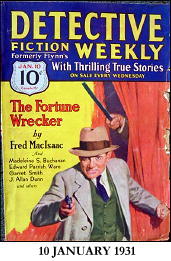
When both Toriano and his beneficiary are found shot in suspicious circumstances – it looks like they killed each other – Beele stirs Captain Ryan to investigate the matter more thoroughly. Beele of course helps the investigation, and coincidentally comes across the two killers a short time later.
“The Picture of a Crime†involves Arty Beele in the murder investigation of a rich man in his mistresses’ apartment. In this story, Harrington, the Telegraph newspaper’s city editor, assigns the news coverage to him and a photographer.
Once on the scene, Beele begins acting like one of the investigating police, asking questions of the suspects and others. There is no real mystery about the murderer, since there are only three suspects.
“Live Bait†is different than other stories in the series. The story opens with Beele getting a tip-off from an underworld connection that he is going to be the target of a local crime lord, who means to kill him. Beele heads to Captain Ryan’s office to tell him the news, and together they come up with a plan to trap Orsini the crime lord. No mystery or murder to solve in this story.
“Strike Three!†is a novelette length story that involves Arty Beele in the planned killing of one liquor gangster by another. One of the gangsters tips off Beele that he will kill an unnamed gangster, and Beele tries to figure out who the victim is to be. He winds up at the Club Chanticleer investigating.
He is asked by Mike O’Mara (the intended victim), to sit in on a meeting between him and Repetti. “It was no new role for him to act as arbiter at a gangster conference.†When O’Mara and Repetti are both murdered, it is Beele who straightens out the confusion as to who killed whom.
“Devil’s Brew†is something of a mystery combined with gangdom interactions. Beele is called in by two of the local liquor barons to help arbiter a problem between the three local liquor barons. Captain Ryan interferes with this work, and all of a sudden one of the barons is mysteriously shot and another disappears. Arty Beele investigates, and puts his life in danger in order to solve the problem.
“The Fragrant Alibi†is another story where Beele assists the police in the solution of a crime. No Captain Ryan here, though. Beele is in a nightclub when a gangland murder takes place, and is involved in the story before the killing takes place. As often is the case, a small clue points out the solution of the crime to Beele.
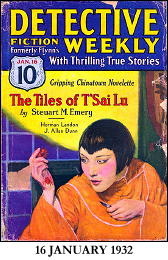
“Cheap at the Price†has Arty Beele investigating another gangland killing, and he is also under threat from the gangster suspected in a number of other killings. Another novelette length story.
“Twenty Grand†is the last story found in the series, and is a good one. There is no murder mystery here; the culprit is known from the beginning. Blacky Frey, a gangster, has killed two people with his .22 rifle. One of these was a policeman, for which he was tried and acquitted due to lack of evidence(the police couldn’t find the rifle). However, Arty Beele thinks up a scheme to have the police catch Frey red-handed with the rifle committing a crime.
This is an average series, with some very good stories, but mostly average or slightly above that. The best stories are the novelette length ones, because they have more scope for description and action and complexity.
There is no element of humor in the stories, and the hardboiled nature of the stories denies any lightness to them. This series about a crime reporter does not measure up to the later crime reporter series that Richard Sale wrote about Daffy Dill. Daffy Dill was a longer running series and much more popular than many other series in DFW.
The Arty Beele series by Ruth & Alexander Wilson:
Killers Have Blue Eyes December 15, 1928
The Silent Witness April 13, 1929
A Ride in the Park August 24, 1929
Death in the Dark April 5, 1930
This Way Out May 10, 1930
A Pain in the Neck September 27, 1930
A Swell Funeral October 18, 1930
Special Delivery January 10, 1931
The Murder of the Seven-Year Itch January 31, 1931
The Picture of a Crime March 7, 1931
Live Bait March 21, 1931
Strike Three! May 2, 1931
Devil’s Brew August 1, 1931
The Fragrant Alibi August 22, 1931
Cheap at the Price November 7, 1931
Twenty Grand January 16, 1932
NOTE: Thanks to Phil Stephensen-Payne for helping put together this checklist of story titles. The cover images also came from his Galactic Central website. Please visit!
Tue 10 May 2011
Posted by Steve under
ReviewsNo Comments
CARTER BROWN – The Strawberry-Blonde Jungle. Belmont Tower, paperback original, 1979.
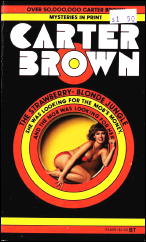
Carter Brown’s back, and he’s got Danny Boyd with him. Brown was a mainstay at Signet for years — sales of over 50,000,000, so says the cover, and not a bad track record at all — before being dropped several years ago.
His kind of story being hard to sink, he’s resurfaced in recent months at Belmont Tower, but with some of the sleazier aspects of his later days at Signet still very much in evidence — if not more.
As for Danny Boyd, he’s moved from Manhattan to Santo Bahia, California, but he’s still a private eye. In his own words, he’s about the ripest bastard he knows, with a penchant for a leer and saying his mind.
This latest case involves a widow’s hunt for some leftover syndicate money, and a reasonable number of complications develop, but it’s your meat only depending on how deeply your craving for bosomy babes and bawdy broads runs in your daily dose of detective fiction.
This is a family magazine, as I’ve remarked before, so I don’t believe I’d better explain the title.
— Reprinted from The MYSTERY FANcier, Vol. 3, No. 6, Nov/Dec 1979 (very slightly revised).
Bibliographic Note: The final Carter Brown novel from Signet may have been The Dream Merchant, which came out in June 1976. When Belmont Tower picked up the franchise in 1979, they published six or so that year, with Donovan’s Delight and The Spanking Girls appearing first, followed by The Strawberry-Blonde Jungle.
Tue 10 May 2011
THE BACKWARD REVIEWER
William F. Deeck
N. A. TEMPLE-ELLIS – The Man Who Was There. E. P. Dutton, US, hardcover, 1930. First published in the UK: Metheun, hardcover, 1930.
In order to hasten his recovery from influenza, Montrose Arbuthnot, criminologist, has taken his faithful but not too bright companion, Sir Edmund King, to the Isle of Wight. One day as they are preparing to golf, the housekeeper from a nearby bungalow informs them that her master had been shot and killed.
They find the corpse, an empty safe, a young man on the veranda reading Palgrave’s Golden Treasury, and Arbuthnot’s card on the floor of the dining room. The corpse’s missing pince-nez is of concern to Arbuthnot, but even more puzzling to him is the hat that cannot be found when the alleged murderer drives off a cliff. “Murderers always wear hats,” Arbuthnot contends.
Amusing and action-filled, with a complex crime and somewhat fair play. Arbuthnot and King are interesting characters, though one does wonder how they manage to tolerate each other’s faults, if indeed Arbuthnot can be said to have faults.
— From The MYSTERY FANcier, Vol. 11, No. 4, Fall 1989.
Bibliographic data: [Taken from the Revised Crime Fiction IV, by Allen J. Hubin.]
TEMPLE-ELLIS, N. A. Pseudonym of N. A. Holdaway, 1894-?
* The Inconsistent Villains (n.) Methuen 1929; Dutton, 1929. [Montrose Arbuthnot]
* The Cauldron Bubbles (n.) Methuen 1930
* The Man Who Was There (n.) Methuen 1930; Dutton, 1930. [Montrose Arbuthnot]
* Quest (n.) Methuen 1931 [Montrose Arbuthnot]
* Six Lines (n.) Hodder 1932
* The Case in Hand (n.) Hodder 1933
* The Hollow Land (n.) Hodder 1934
* Three Went In (n.) Hodder 1934 [Insp. Wren]
* Dead in No Time (n.) Hodder 1935 [Montrose Arbuthnot; Insp. Wren] US title: Murder in the Ruins, Dial, 1936
* Death of a Decent Fellow (n.) Hodder 1941 [Insp. Wren]
Note: Temple-Ellis’s first book, The Inconsistent Villains, was the winner of the publisher’s Detective Story Competition of the year, beating Josephine Tey’s classic The Man in the Queue.
Mon 9 May 2011
RICHARD FORREST – The Wizard of Death. Bobbs-Merrill, hardcover, 1977. Pocket, paperback, 1978.

Connecticut residents will get a kick out of this inside view of state gubernatorial politics. When the nominee Randolph Llewyn is assassinated at a political rally, it appears that writer Lyon Wentworth’s wife is the next target. Bea Wentworth is a state senator and has a great deal of influence over who the next nominee will be.
The Chamber of Commerce is not likely to be pleased with some of ground covered during the course of the investigation, including the hangouts of several motorcycle clubs lobbying against the helmet bill and the sleazier side Hartford’s massage parlors.
The whole business is pretty unlikely, and one fears that it’s also quite superficial. But it reads quickly, and it is fun at times to indulge your fantasies.
— Reprinted from The MYSTERY FANcier, Vol. 1, No. 5, September 1977 (very slightly revised). This review also appeared earlier in the Hartford Courant.
The Bea & Lyon Wentworth series —
A Child’s Garden of Death (n.) Bobbs 1975.
The Wizard of Death (n.) Bobbs 1977.
Death Through the Looking Glass (n.) Bobbs 1978.
Death in the Willows (n.) Holt 1979.
The Death at Yew Corner (n.) Holt 1980.
Death Under the Lilacs (n.) St. Martin’s 1985.
Death on the Mississippi (n.) St. Martin’s 1989.
The Pied Piper of Death (n.) St. Martin’s 1997.
Sun 8 May 2011
REVIEWED BY MICHAEL SHONK:
JASPER FFORDE – One of Our Thursdays Is Missing. Hodder Library, UK, hardcover, February 2011. Viking, UK, hc, March 2011.
Jasper Fforde is among the top writers in “cross-genre anarchy.” A prime example of the genre is One of Our Thursdays Is Missing, a book with a blend of every genre in the library except pornography and non-fiction.
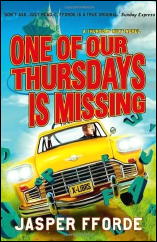
The Thursday Next series we read does not exist in the Nextian Universe where the alternative reality of RealWorld and the world of the written word in BookWorld are located. The Nextian version of the Thursday Next books is the home of Written Thursday and read by the people of RealWorld.
RealWorld Thursday has the unique ability to travel between RealWorld and BookWorld. There has been more than one Written Thursday, the current one is dealing with self-esteem issues trying to live up to the racy Written Thursday she replaced and her idol RealWorld Thursday.
This is the sixth book in the Thursday Next series and features a major change in protagonist. It is told from the point of view of Written Thursday as RealWorld Thursday is missing. Written Thursday’s narration does more than just tell the story, through her we discover what it feels like to be unread, almost remaindered.
We experience the frustration of losing one’s own identity in the middle of a conversation because the “ghostwriter” has stopped using “she says” or “he said” until none of the characters know who said what. We learn the difference between reality and fiction, but from fiction’s point of view.
The story begins on the big day when BookWorld changes from the Giant Library into a geographic world. Meanwhile, the possibility of Civil War between Racy Novel and Women’s Fiction is growing more likely.
The Thursday Next books, located in fantasy, are suffering from such a serious drop in readers the actors playing the characters are worried about their future, and blaming Written Thursday for the lack of readers. But soon Written Thursday is faced with even more serious problems.
Jurisfiction, BookWorld’s police, asks Written Thursday to solve the mystery of an unknown book that had mysteriously exploded over BookWorld. When Written Thursday finds evidence of sabotage, she finds herself dangerously in the middle of a deadly conspiracy that could destroy BookWorld.
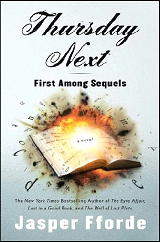
There is much in this story to please the mystery reader. Why was the book destroyed? What was its title, and who was its author? Who do the secret police Men In Plaid really serve? Why is someone trying to start a war between Racy Novel and Women’s Fiction? What role does RealWorld evil corporation Goliath play in the conspiracy and why? And where is the RealWorld Thursday Next?
The humor has much to offer readers of all genres. For mystery fans, Written Thursday describes a scene in the land of Thriller:
“There were a few traveling artisans, salesmen, and a dozen or so tourists, apparently on a Get Beaten Senseless by Bourne package holiday, which had just overtaken the Being Shot in the Leg by Bond break for popularity, much to the Fleming camp’s disgust.”
While I recommend you read the Thursday Next series in order, it is possible to enjoy this book by itself. Each book in the series has a satisfying ending but leaves enough plot threads open to set up the next book.
For example, here we learn why, in First Among Sequels, RealWorld Thursday was the only one who could see her second daughter, Jenny. In One of Our Thursdays Are Missing, we are left with unanswered questions about Goliath’s current evil plan in the RealWorld.
Answers to those questions will most likely be revealed in TN7. However, the mysteries of the BookWorld conspiracy are solved at the end, as is what happened to RealWorld Thursday.
The Thursday Next series continues to satisfy fans of quality satire, mystery, and any other genre.
The Thursday Next series —
1. The Eyre Affair (2001)
2. Lost in a Good Book (2002)
3. The Well of Lost Plots (2003)
4. Something Rotten (2004)
5. First Among Sequels (2007)
6. One of Our Thursdays Is Missing (2011)
Sun 8 May 2011
IT IS PURELY MY OPINION
Reviews by L. J. Roberts
CHRISTOPHER FOWLER – Bryant & May Off the Rails: A Peculiar Crimes Unit Mystery. Bantam, hardcover, September 2010; trade paperback, September 2011. Originally published in the UK: Doubleday, hardcover, June 2010.
Genre: Police procedural. Leading characters: Arthur Bryant & John May; 8th in series. Setting: England.
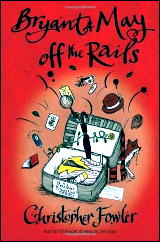
First Sentence: With regard to your apprehension of the hired assassin operating in the King’s Cross area, this so-called “King’s Cross Executioner” chap, thank you for acting so quickly on the matter, although it’s a pity he subsequently managed to give you the slip.
A killer known as Mr. Fox has been captured by Detectives Arthur Bryant and John May, but escaped, murdering one of their colleagues in the process. A body has been discovered in a station of London’s Underground. Was Mr. Fox the killer or does the Peculiar Crimes Unit have another killer on their hands?
Okay, I’ll start right out by admitting I love Bryant and May. In them, Fowler ha created two of the most appealing characters being written today. And it is truly Fowler’s excellent writing and voice which brings them, and the story, to life.
I have always appreciated books which include a cast of characters. Fowler found a particularly clever way of incorporating his cast of principal characters into the story as a staff roster. In this book, he provides a description of Bryant which truly does give “some measure of the man,†and I love his Bryant’s habit of reciting dictionary definitions.
Bryant and May, while being the central characters, are not alone but supported by a host of secondary characters each given distinct backgrounds, characteristics and contributions to the story. With each book, we learn more of each character’s background and personalities. But beyond the central characters, it is a rare author who can make one feel an element of sympathy for a series killer, but Fowler manages so to do.
There is wonderful humor balanced by touching poignancy. There is a balance of historical information — the London Underground system — with very contemporary references — the use of a flash mob as a distraction. It is the inclusion of small details about which one normally doesn’t think; such as the inclusion as to why escalators are always breaking down and the comparison between actors and serial killers, which I appreciate.
This is a book where one should have read the previous books in the series. That is no great burden, however, as all the Bryant and May stories are so well done and delightful to read. I should hate to see this series end so, please, give them a try, spread the word and enjoy Bryant and May. Off the Rails is another excellent addition to the series.
Rating: Excellent.
The Bryant & May series —
1. Full Dark House (2003)
2. The Water Room (2004)
3. Seventy-Seven Clocks (2005)
4. Ten Second Staircase (2006)
5. White Corridor (2007)
6. The Victoria Vanishes (2008)
7. Bryant and May on the Loose (2009)
8. Off the Rails (2010)
9. The Memory of Blood (2011)
Sat 7 May 2011
REVIEWED BY WALTER ALBERT:
THE MOLLYCODDLE. Fairbanks-United Artists, 1920. Douglas Fairbanks, Ruth Renick, Wallace Beery. Director: Victor Fleming. Shown at Cinecon 44, Hollywood CA, Aug-Sept 2008.
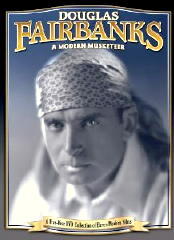
The films that Fairbanks made before the success of Robin Hood propelled him into the big-budget historical epics for which he is now remembered may not be as visually sumptuous as his later work, but they are every bit as entertaining.
In this, his third United Artists release, Fairbanks plays Richard Marshall V, the descendant of a line of risk-takers and adventurers, who is the “Mollycoddle” of the title, a term coined by Theodore Roosevelt to characterize a spoiled, frivolous young man.
Attracted to a young woman in Monte Carlo, he insinuates himself into her group, a party formed by villainous diamond smuggler Henry Van Holkar (Wallace Beery) that is shortly to set off as a cover for an Arizona tour where Van Holkar will pick up another supply of diamonds for delivery to Amsterdam.
The Arizona excursion proves to be the making of Richard, who performs spectacular stunts that prefigure the Fairbanks roles shortly to follow. The most spectacular stunt, in which Marshall leaps from a cliff to a tree, was filmed with a double because of injuries Fairbanks sustained in an earlier stunt.
The doubling is seamlessly shot, with the dastardly villain foiled and the intrepid hero and fair maiden reunited. All of the early Fairbanks films are wonderfully entertaining; ten of them, including The Moddycoddle, I am delighted to say, are included in a reecnt DVD set from Flicker Alley.
Editorial Note: In that set referred to by Walter are: His Picture in the Papers / The Mystery of the Leaping Fish / Flirting With Fate / The Matrimaniac / Wild and Woolly / Reaching for the Moon / When the Clouds Roll By / The Mollycoddle / The Mark of Zorro / The Nut.
Sat 7 May 2011
Posted by Steve under
Reviews[3] Comments
IT’S ABOUT CRIME, by Marvin Lachman
ROBERT C. S. ADEY & DOUGLAS G. GREENE, Editors – Death Locked In. International Polygonics Ltd, softcover, 1987. Hardcover reprint: Barnes & Noble, 1994.
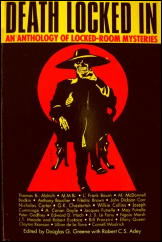
Death Locked In is a generous collection of twenty-four stories covering 553 pages. Its editors, Robert C. S. Adey and Douglas G. Greene, are two of the world’s leading experts on the locked room mystery. Lest those who are not devotees of the classical puzzle be put off, I will point out that this book contains great variety, though all stories have one common denominator: a locked room.
From the pulps are stories by Fredric Brown and Cornell Woolrich. There is a science-fiction mystery by Anthony Boucher. Ngaio Marsh, quite appropriately, uses a theatrical setting. Even Bill Pronzini’s nameless private eye solves one. Early locked-room stories by Thomas Bailey Aldrich, L. Frank Baum of Oz fame, Nick Carter, and Wilkie Collins are included.
Finally, we have the best practitioners of this wonderful sub-genre: John Dickson Carr, Edward D. Hoch, and Ellery Queen with a reprint of one of his famous radio mysteries. Each story in the book has a learned introduction, telling interesting information about the author and putting the story into historical perspective.
— Reprinted from
The MYSTERY FANcier,
Vol. 9, No. 5, Sept-Oct 1987.
Fri 6 May 2011
REVIEWED BY DAN STUMPF:
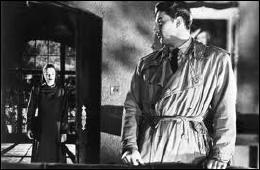
OUT OF THE PAST. RKO, 1947. Robert Mitchum, Jane Greer, Kirk Douglas, Rhonda Fleming, Richard Webb, Steve Brodie, Virginia Huston, Paul Valentine. Screenplay by Geoffrey Homes (Daniel Mainwaring) based on his novel Build My Gallows High. Cinematography by Nicholas Musuraca. Director: Jacques Tourneur.
I recently took time out to revisit the ultimate film noir, Out of the Past, (RKO, 1947) and the book it was based on, Build My Gallows High (Morrow, 1946) by Geoffrey Homes.
I wasted an awful lot of my precious youth reading other books by Homes, thinking on the strength of Gallows that he must be pretty good. ’Tain’t so. In fact, Homes’ book, which suffers from over-complication and a surfeit of stock characters, is perceptibly inferior to the screenplay he adapted from it.
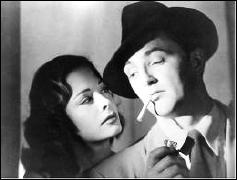
The film’s plot is still dense and impenetrable, but the characters are more developed and streamlined, the action is well-calculated and surprisingly stark, and though the nature of the story is quite leisurely, momentum never flags, probably thanks to director Jacques Tourneur, who learned early on in his career how to get things moving, and cinematographer Nicholas Musuraca, who fills the screen with some truly striking imagery.
Interestingly, though the book Build My Gallows High is written in the third person, the movie Out of the Past is very much a first-person thing; Robert Mitchum narrates most of the first half as he recounts the story of why he has to go to Tahoe and pay a call on gang-boss Kirk Douglas. It seems years ago
(WARNING! PLOT DETAILS AHEAD!!)
Mitchum was hired to find Douglas’ runaway mistress Kathy (Jane Greer) but ended up running off with her and living happily ever etc. until she framed him for murder and ran out on him.
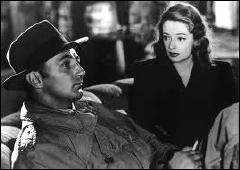
Well, we’ve all had relationships like that, and all this is told voice-over by Mitchum till he arrives at Tahoe and finds Kathy there, once again sharing Douglas’ bed.
That, as I say, is the first half. Having brought us up to date,
(WARNING! Continued.)
the movie gets Mitchum embroiled in a blackmail scheme and involved with a second femme fatale, this one named Meta and played by Rhonda Fleming as a less-classy version of Kathy.
For this second half of the film, there is no more voice-over, but Tourneur and Musuraca increasingly photograph Mitchum from behind or in silhouette, and they employ more subjective shots, showing events from his point of view, visually forcing us to identify with the character, though he’s no longer narrating.
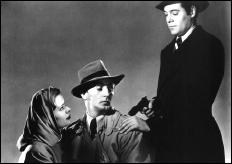
And then there’s a moment no one talks about: having been betrayed by Meta, Mitchum makes his way back to her apartment and hides there to wait for her return. The door opens and Kathy comes in, goes to the phone and identifies herself as Meta.
Now logically, there’s no reason for her character to even be in that part of the country, but dramatically, it makes such perfect poetic sense for the two femme fatales to merge into each other that most reviewers don’t even notice.
Mention should also be made — and here it is — of an actor named Paul Valentine [above, on the right] who plays Douglas’s sinister gofer. Smooth, balletic, and lethal, displaying an easy-going manner that never seems less than deadly, it’s an outstanding performance that should have led to bigger things. But alas, did not.
« Previous Page — Next Page »

